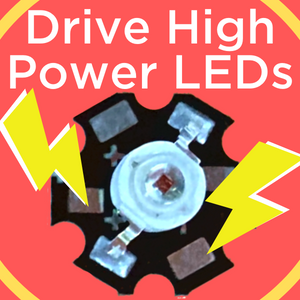Hey all, just put the finishing brushstrokes on the guide How to Drive High Power LEDs
This guide will provide all the knowledge to power whatever High Powered LED you come across but will focus on 3W Aluminum Backed Star LEDs. From selecting the right gauge of wire to managing heat dissipation and the power requirements.
High Power Light Emitting Diodes have different requirements that need to be met when compared to regular LEDs. Furthermore, LEDs are unlike other traditional incandescent lights where higher voltages produce brighter light. The amount of light (Lumens) an LED emits depends on how much current is supplied.
If you connected a standard DC voltage regulated power supply to a line of LEDs it would provide too much current to the LEDs and cause them to break. This is why we need a Constant Current LED Driver between the DC power supply and the LEDs. The technology of buck, boost, and buck-boost (Step Down or Step Up) converters are utilized around the world to provide regulated low-voltage DC/DC power in nearly every electronics market. Importantly these devices manage and prevent excess current flow. If the voltage and current from the chosen power supply are too high for the LEDs you will need a buck (step-down) converter. If voltage and current from the power supply are too low for the LEDs you will need a boost (step-up) converter.

Read more
2 Likes
Thanks for sharing with us.
1 Like
In the image of the multimeter measuring the current output from the driver it shows the meter connected directly across the output terminals for both voltage and current with the leads input connections to the mm changed for voltage and current. I thought current can only be measured when a load is in the circuit so the mm would be connected in the line feed to the led. As this is not what is showing in the image is the mm providing the load in this instance?
Hope you can advise
2 Likes
Hi @Leslie62519 you are correct current is usually measured in circuit.
The supply @Tim is using has a current limit built it. In this instance @Tim was measuring the short circuit current of the supply so the current limit can be set to what is needed.
btw measuring short circuit current puts a significant strain on the supply, it is not something you would normally or should normally do. Especially on a supply like a battery that has no built in current limit.
Cheers
Jim
3 Likes
Hi there,
If I wanted to control (on/off, not changing brightness) a 3W LED from a Pico, would I need to use a relay, or could I just power it straight from the GPIO?
Thanks,
Josh.
1 Like
Hi J
The Pico I/O will not supply enough current for a 3W LED I don’t think. You would have to switch an external LED power supply somehow. Relay, Mosfet or whatever.
Cheers Bob
4 Likes
@J199799 Following from datasheet for Pico.
Here’s a more detailed breakdown:
- Current Capability: The Pico’s GPIO pins are capable of supplying up to 3.3 volts and a maximum of 12mA.
- Setting Current: You can configure the current a pin can supply to 2mA, 4mA, 8mA, or 12mA.
- Default Current: By default, a pin is set to 4mA.
- Powering Small Components: The GPIO pins are suitable for powering small components like LEDs, but not larger devices that require more current.
Using Ohms law, 3W at 3V3 equates to current of almost 1A.
The first post by @Tim has a heap of good information in it.
Regards
Jim
2 Likes

